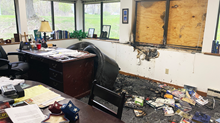Update (June 25): In the days following the release of the federal government's "Guide for Developing High-Quality Emergency Operating Plans for Houses of Worship," CT has gathered responses from leading voices on church safety. Their verdict? The guide is a good reminder for churches—especially smaller ones—to think about security.
"[The guide] is consistent with generally accepted security planning procedures and standards, and I find nothing in the document that would lead readers on a dangerous misdirection ….There should be a plan familiar to those tasked with security planning and operations (This guide takes us through that very well), but there should also be a simple plan (i.e. summary, flip chart, quick guide) familiar to all staff and volunteers. Not only in a simple document form, but also in training protocols. This component is absent from the document. While it would be picked up by experienced security operators, it should be mentioned as a primary need in this guide."
Carl Chinn, church security expert
"The challenge is getting churches to think about emergency preparedness and planning, and this gives them a good starting point. I think it's really more for those churches that haven't gone through that process, this gives you a plan….(The guidelines emphasize that ) you should review those emergency plans at least once a year anyhow."
Frank Sommerville, attorney and editorial advisor for CT sister publication Church Law & Tax
"[The federal risk assessment guide] appears to be very comprehensive and detailed. We have been urging congregations to put together an emergency action plan. [The guide] is a nice piece for helping churches assess and prioritize which risk to look at first."
Eric Spacek, Risk Management & Loss Control Senior Manager, GuideOne Insurance
"I think there are a lot of churches that will make plans because of the guidelines…. You'd think that larger churches would make larger targets, but they have a lot of security in place."
Dave Travis, Chief Executive Officer at Leadership Network
-----
Given that deaths from church attacks surged 36 percent last year, the White House has–for the first time–told churches and other houses of worship how they should respond to a gunman.
The most interesting detail: Encouragement to not only run and hide, but to fight back as a last resort.
The Obama administration's "Guide for Developing High-Quality Emergency Operating Plans for Houses of Worship" tells churches how to respond to "Active Shooter Situations," as well as natural disasters and other types of emergencies.
The guide is part of a series of online resources, training procedures, and support for houses of worship, schools, colleges, and universities.
"The question of how best to subdue a gunman is likely to rekindle a debate within many churches, particularly in parts of the country where it is common to carry weapons," notes RNS. "Should congregants bring guns to church?"
Churches and other places of worship are often "soft targets" for the criminally-inclined now that security at other public places has increased, said Carl Chinn, an expert on church security, in an interview last year with CT sister site Managing Your Church. He believes churches should take the time to have a safety plan in place, regardless of their size or resources. "Be aware," he said. "Do simple things to make sure people are safe."
Chinn calculates that deaths from church attacks surged 36% last year. CT has previously spotlighted how the surge in church shootings is real, prompting pastors to rethink security at church services.

Support Our Work
Subscribe to CT for less than $4.25/month


















